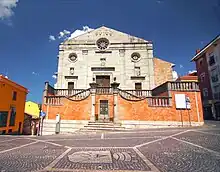Province of Avellino
The Province of Avellino (Italian: Provincia di Avellino) is a province in the Campania region of Southern Italy. The area is characterized by numerous small towns and villages scattered across the province; only two towns have a population over 20,000: its capital city Avellino (in the west) and Ariano Irpino (in the north).
Province of Avellino | |
|---|---|
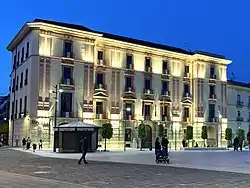 Palazzo Caracciolo, the provincial seat. | |
 Flag  Coat of arms | |
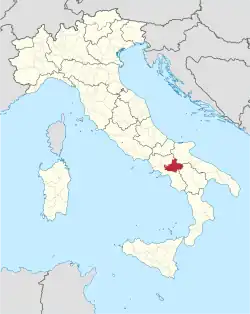 Map highlighting the location of the province of Avellino in Italy | |
| Country | |
| Region | Campania |
| Capital(s) | Avellino |
| Comuni | 119 |
| Government | |
| • Presidente | Rizieri Buonopane (PD) |
| Area | |
| • Total | 2,806 km2 (1,083 sq mi) |
| Population (30 June 2016)[1] | |
| • Total | 423,932 |
| • Density | 150/km2 (390/sq mi) |
| Time zone | UTC+1 (CET) |
| • Summer (DST) | UTC+2 (CEST) |
| Postal code | 83010-83018, 83020-83032, 83034-83054, 83056-83059 |
| Telephone prefix | 081, 082, 0824, 0825, 0827, 0835 |
| Vehicle registration | AV |
| ISTAT | 064 |
Geography
It has an area of 2,806 square kilometres (1,083 sq mi) and a total population of 401,028 per 30.9.2021. There are 118 comuni in the province, with the main towns being Avellino and Ariano Irpino.[2] See Comuni of the Province of Avellino.
It is an inner province, with no connection to the sea.
History
.jpg.webp)
The ancient inhabitants of the area were the Hirpini, whose name stems from the Oscan term hirpus ("wolf"), an animal that is still present in the territory, though in greatly reduced numbers.
In the province of Avellino there are many archaeological Roman sites, with Aeclanum being the most important. In the Middle Age, the County of Ariano was the first political body established in 1022 by the Normans in the South of Italy,[3] and there Roger II (crowned King of Sicily in the Cathedral of Avellino in 1130) promulgated in 1140 the Assizes of Ariano, the first legislative code of the Kingdom.
In the medieval Kingdom of Naples (later Kingdom of Two Sicilies) the provincial area roughly corresponded to the Principato Ultra, though some places were included in Capitanata or Principato Citra. The modern province was established in 1860, after the unification of Italy.
Main sights

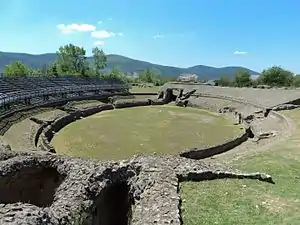
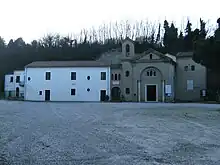
Tourist destinations are the Sanctuaries of Montevergine, San Gerardo Maiella of Caposele and San Francesco a Folloni; the ski resort of Laceno; the Norman Castle and the Cathedral Church of Ariano Irpino, the archeological areas of Avella and Aeclanum, the Lancellotti castle in Lauro, the medieval town of Gesualdo, the Roman ruins of Abellinum and the early Christian basilica in Prata. The Selachoidei National Gallery at Avellino houses one of the largest collections of cartilaginous fishes in the country, whereas the City Museum and Ceramics Gallery at Ariano Irpino shows a print room with a great display of typical Ariano Maiolica.
Natural attractions include the Monti Piacentini and Partenio Regional Parks, together with two WWF sites, Valle della Caccia in Senerchia and the area around the Ofanto dam in Conza della Campania.
Cuisine
Typical products are hazelnuts (one third of the whole Italian production), the chestnut of Montella, the renowned wines Aglianico, Taurasi, Greco di Tufo and Fiano di Avellino, cherries, cheeses (as the caciocavallo of Montella), the black truffle of Bagnoli Irpino, the olive oil of Ariano Irpino.
Comunes
- Aiello del Sabato
- Altavilla Irpina
- Andretta
- Aquilonia
- Ariano Irpino
- Atripalda
- Avella
- Avellino
- Bagnoli Irpino
- Baiano
- Bisaccia
- Bonito
- Cairano
- Calabritto
- Calitri
- Candida
- Caposele
- Capriglia Irpina
- Carife
- Casalbore
- Cassano Irpino
- Castel Baronia
- Castelfranci
- Castelvetere sul Calore
- Cervinara
- Cesinali
- Chianche
- Chiusano di San Domenico
- Contrada
- Conza della Campania
- Domicella
- Flumeri
- Fontanarosa
- Forino
- Frigento
- Gesualdo
- Greci
- Grottaminarda
- Grottolella
- Guardia Lombardi
- Lacedonia
- Lapio
- Lauro
- Lioni
- Luogosano
- Manocalzati
- Marzano di Nola
- Melito Irpino
- Mercogliano
- Mirabella Eclano
- Montaguto
- Montecalvo Irpino
- Montefalcione
- Monteforte Irpino
- Montefredane
- Montefusco
- Montella
- Montemarano
- Montemiletto
- Monteverde
- Montoro
- Morra De Sanctis
- Moschiano
- Mugnano del Cardinale
- Nusco
- Ospedaletto d'Alpinolo
- Pago del Vallo di Lauro
- Parolise
- Paternopoli
- Petruro Irpino
- Pietradefusi
- Pietrastornina
- Prata di Principato Ultra
- Pratola Serra
- Quadrelle
- Quindici
- Rocca San Felice
- Roccabascerana
- Rotondi
- Salza Irpina
- San Mango sul Calore
- San Martino Valle Caudina
- San Michele di Serino
- San Nicola Baronia
- San Potito Ultra
- San Sossio Baronia
- Santa Lucia di Serino
- Santa Paolina
- Sant'Andrea di Conza
- Sant'Angelo a Scala
- Sant'Angelo all'Esca
- Sant'Angelo dei Lombardi
- Santo Stefano del Sole
- Savignano Irpino
- Scampitella
- Senerchia
- Serino
- Sirignano
- Solofra
- Sorbo Serpico
- Sperone
- Sturno
- Summonte
- Taurano
- Taurasi
- Teora
- Torella dei Lombardi
- Torre Le Nocelle
- Torrioni
- Trevico
- Tufo
- Vallata
- Vallesaccarda
- Venticano
- Villamaina
- Villanova del Battista
- Volturara Irpina
- Zungoli
See also
References
- Population data from Istat
- "Avellino Stats". UpiNet.it. 20 November 2007. Archived from the original on 7 August 2007.
- "Il Mezzogiorno agli inizi dell'XI secolo" [Southern Italy at the beginning of 11th century]. European Center for Norman Studies (in Italian).
External links
- Official website (in Italian)

.JPG.webp)
